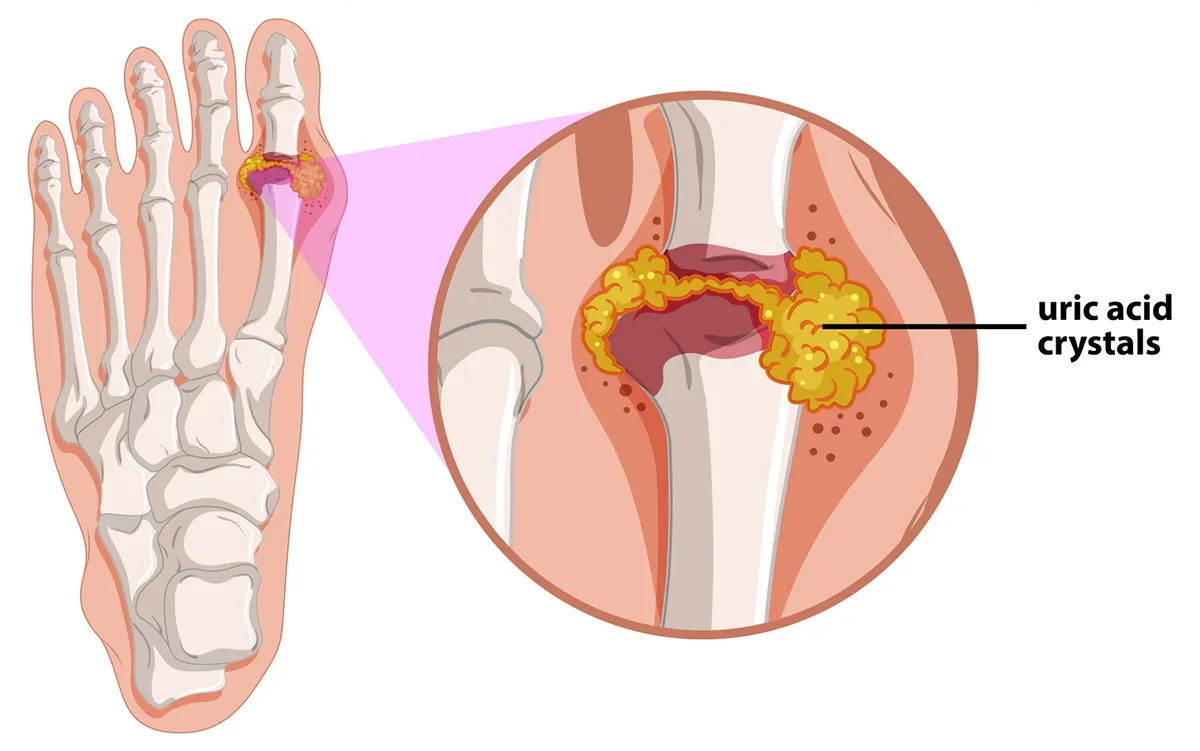Your session is about to expire
Learn More About Gout Research Studies
What Are Gout Research Studies?
Gout is a common but painful form of inflammatory arthritis that usually affects a single joint at a time. However, there are frequent ups and downs that expose the patients to either a period of "flares" (worsening symptoms) or a period of "remission" (when there are no symptoms at all).
Gout research studies look mainly into how it leads to functional impairment, contributes to a diminished quality of life, and how it impacts patient mortality and morbidity. Since there is no permanent cure for gout, the condition is only expected to worsen in the absence of prompt diagnosis and treatment.
The biggest aim of gout research studies is to find treatments that directly address the condition instead of addressing the symptoms. As of now, treatments mainly focus on reducing symptoms from worsening and preventing any future flare-ups.

Why Is Gout Being Studied Through Research Studies?
Gout is not only a systemic and chronic disease. It is also progressive and needs to be addressed as early as possible. However, due to a lack of research in the area.
Since it is the most common crystal arthropathy and also a leading cause of inflammatory arthritis, studying it through research is imperative. Unfortunately, it is still underdiagnosed and under-treated. While there have been some advances in treatment strategies, most patients suffer from improper management, due to which their recurrent flares continue.
It was mainly due to clinical trials and research studies that advancements in the condition's diagnosis and treatment were observed in the past. For example, due to new imaging modalities and novel urate-lowering therapies, there is increasing hope that there will be better patient outcomes and improved gout care in the future.
Furthermore, research studies look into whether a drug or therapy is safe, has side effects, or can help treat the symptoms of gout effectively. For instance, there are many studies on the benefits of urate-lowering therapies for symptoms like tophi and flares. However, they're still not enough to determine how gout treatment can have an impact on long-term health outcomes.
What Are The Types of Treatments Available For Gout?
While there are no treatments to address the condition directly, there are medications to treat gout attacks. Some of them include the following:
NSAIDS
Nonsteroidal anti-inflammatory drugs such as naproxen sodium and ibuprofen are often prescribed as painkillers. However, they may carry the risks of ulcers, bleeding, and stomach pain.
Corticosteroids
Corticosteroids address the issues of gout pain and inflammation. While they usually exist in the form of pills, they can also be injected into the joint. Some side effects include increased blood pressure, high blood sugar levels, and frequent mood changes.
Colchicine
Colchicines such as Mitigare and Colcrys are usually recommended to address the issue of gout pain. Common side effects include diarrhea, vomiting, and nausea.
Xanthine Oxidase Inhibitors
XOIs such as allopurinol and febuxostat work by reducing uric acid production in the body. However, a major downside of these drugs is that they can induce an acute gout attack after intake.
They may even worsen the attack if consumed during it. This is why a short colchicine course is also prescribed alongside xanthine oxidase inhibitors. Common side effects include nausea and rash.
Probenecid
Probenecid is a drug that facilitates the removal of uric acid from the blood. However, as with every other medication, it also comes with a bunch of side effects, such as kidney stones, upset stomach, and rashes.
Lifestyle Changes
Even though prescribing medication is the first course of action taken by healthcare professionals, making lifestyle changes also go hand in hand.
Some of them include losing weight, exercising regularly, avoiding food items high in purines, and choosing healthier beverages. Low-fat dairy products are a better choice for daily protein intake.

What Are Some Recent Breakthrough Research Studies on Gout?
2019: Blocking TAK1 Can Suppress Inflammation Caused By Gout
The Washington State University researchers identified that blocking TAK1 (a signaling molecule) can suppress gout-related inflammation. The condition roughly affects about 8.3 million people in the United States, which is why the research has given hope for the development of new treatment strategies that could improve the prognosis for millions of people.
Since gout is caused by high levels of uric acid in the blood, it's reasonable to conclude that foods high in purines, such as beer, red meat, and seafood, are major contributors to those levels. High uric acid further leads to the creation of MSU or monosodium uric acid crystals. These crystals are automatically perceived as a danger, and so the body increases the cytokine protein production that triggers extreme pain and inflammation.
While it was already known that MSU crystals activated the inflammasome pathway, this study also found that MSU crystals use an alternate pathway that triggers inflammation through TAK1. The findings led to further experimentation of a drug that inhibits the attachment of IL-1-beta to its respective receptor. While it is a promising finding, the drug isn't used for gout clinically and is usually administered through infusion. Furthermore, its effectiveness may be limited, and there may also be potential infection risks in the long run. Hence, the research aims to lead trials for drugs to inhibit TAK1 that can be taken orally to manage gout flare-ups at home.
2021: Urate Lowering Therapy in the Treatment of Gout
Researchers from the Boston University School of Medicine and University of Nebraska Medical Center led a 72-week long trial including 950 patients in the veteran's hospital. These 950 patients were given one of the two drugs (febuxostat or allopurinol) to reduce their serum urate levels.
The results showed that febuxostat was not superior to allopurinol, and the latter produced almost the same rates of flaring for patients who had and did not have chronic kidney disease. All in all, 80% of patients were able to achieve target levels of uric acid (under 6.0 mg/dL), and about 90% were able to achieve levels under 6.8 mg/dL. There was zero difference according to the treatment for lowering uric acid. No difference was found in patients who had chronic kidney disease.
The trial demonstrated that titrating therapies for lowering urate levels to serum urate targets could lower crucial outcomes of flares. It also demonstrated that when allopurinol was titrated to doses higher than 300 mg, it worked just as well as febuxostat, a pricier medication.
2021: Pegloticase Treatment for Uncontrolled Gout in Kidney Transplanted Patients
Through this research, researchers aimed to determine whether giving Krystexxa with immunomodulatory drugs could increase its efficacy. The study involved 20 patients with severe gout who were given immunomodulatory drugs such as azathioprine and methotrexate.
In patients who went ahead with 24 weeks of complete treatment, a significant reduction in uric acid levels and overall pain were observed. Researchers also reiterated that since gout is a progressive disease, it must be treated early and aggressively.
Through this analysis of the medication stated above, researchers were able to conclude that it added significantly to the data supporting the safe and effective use of immunomodulation for this particular group of patients. Findings also suggest that using this therapy improves the persistence of pegloticase. Overall, the findings were consistent with existing analyses and earlier clinical trials.
Who Are Some Of The Key Opinion Leaders / Researchers / Institutions Conducting Gout Research Studies?
The University of Minnesota, School of Public Health
The School of Public Health at the University of Minnesota is one of the premier institutions leading research in various matters of public health. The School credits itself for preparing some of the most influential leaders in the field and providing the knowledge that communities and health departments require to make the right decisions for the public. The School of Public Health also recently, through research, concluded that more studies about gout medications are required in order to be more certain about making treatment recommendations.
The University of Florida Health has a diverse constellation of research centers, health colleges, patient care programs, faculty physician practices, and hospitals. Academic health centers conduct research and discover ways to make breakthroughs in patient care. With patients at the heart of everything they do, the institute strives for the best clinical outcomes for health centers nationally. Their mission is to promote health through high-quality patient care and innovative education in biomedical sciences. The institute is also facilitating research for gout and has posted extensive material about the condition to educate the masses and encourage them to seek treatment immediately.
Washington State University is a public research university that has served the community for more than 130 years. The institute strives to improve lives by serving public interests and leading research in various public health matters. With 11 academic colleges, six campuses, and four research and extension centers, the university has a statewide reach. Furthermore, the institute takes pride in being one of the leading research universities in the country.
Researchers are encouraged to explore old as well as new problems so they can discover new solutions in every field, be it sciences, humanities, or arts. Recently, Washington State University researchers were also able to identify a new therapeutic target for treating gout, a condition that causes immense pain and stiff joints. The study, which was published in the journal "Cellular and Molecular Immunology," suggested that inflammation caused by gout can be suppressed by blocking a signaling molecule called TAK1.
The Gout Education Society was formed in 2005, and since then, it has been serving as a nonprofit organization of healthcare professionals. It strives to serve society by educating the masses and the wider healthcare community about gout and related conditions. Apart from improving the quality of care, the organization also aims to minimize the burden of the condition by offering various resources to the masses, which include both medical professionals and the public.
Every year, it also holds a National Gout Awareness Day on May 22 to raise greater public awareness about the condition affecting roughly 8.3 million Americans today. Furthermore, it facilitates studies and clinical trials to help the healthcare community diagnose and treat the condition effectively. Through these clinical trials, the Gout Education Society aims to seek approval for the tested medications from the US Food and Drug Administration.